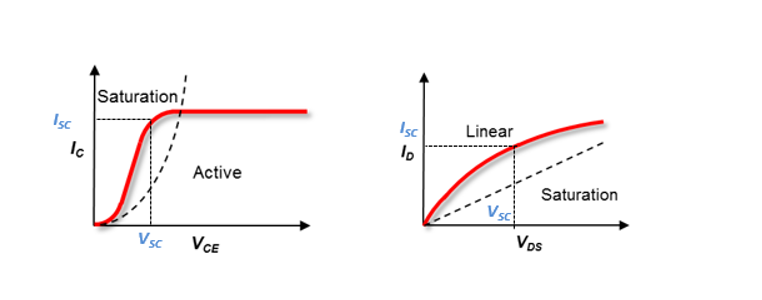SLUAAY2 December 2024 ISO5451 , ISO5451-Q1 , ISO5452 , ISO5452-Q1 , ISO5851 , ISO5851-Q1 , ISO5852S , ISO5852S-EP , ISO5852S-Q1 , UCC21710 , UCC21710-Q1 , UCC21717-Q1 , UCC21732 , UCC21732-Q1 , UCC21736-Q1 , UCC21737-Q1 , UCC21738-Q1 , UCC21739-Q1 , UCC21750 , UCC21750-Q1 , UCC21755-Q1 , UCC21756-Q1 , UCC21759-Q1
4 Short-Circuit Protection Approaches
There are two major protection approaches applicable in terms of detecting short-circuit (SC) and over-current (OC) events.
- Current threshold (ISC)-based protection
- Voltage threshold (VSC)-based protection
- Current threshold
(ISC)-based protection
- During both SC and OC events, the current is increased at least 10x or more, so detecting the increased ICE/ID accurately is one of the approaches to detect the OC/SC event. The detection logic needs to be defined so that the detection current threshold is at least 1.5 to 2 times higher than the maximum operating current. Providing enough margin helps to avoid false detection during the maximum operating current.
- Voltage threshold
(VSC)-based protection
- Based on IGBT and SiC power module IV characteristics, another approach to detect the OC/SC event is by measuring the voltage across the power module effectively to detect the faulty condition. During the OC/SC event, the voltage across the power module (both VCE and VDS) increases to a much higher value than the normal operating condition. The current saturation characteristic in an IGBT gives us a very clear VCE voltage at which point you can decisively say the IGBT is leaving the saturation region, or “De-saturating". In case of SiC, it is recommended to define 2x the normal operating voltage to detect the OC/SC threshold.
 Figure 4-1 VSC and
ISC Thresholds on IGBT and SiC IV Curves
Figure 4-1 VSC and
ISC Thresholds on IGBT and SiC IV Curves